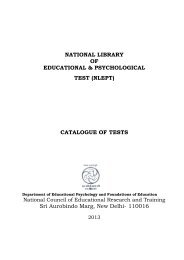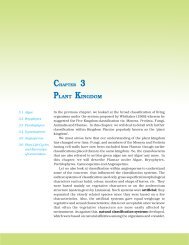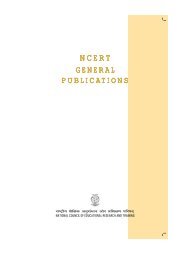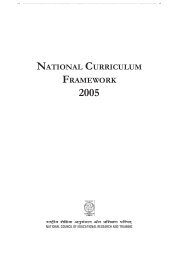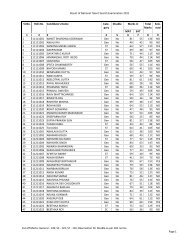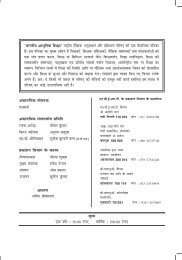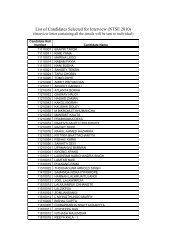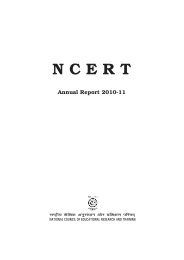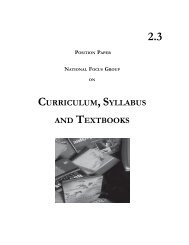indian education - National Council Of Educational Research And ...
indian education - National Council Of Educational Research And ...
indian education - National Council Of Educational Research And ...
Create successful ePaper yourself
Turn your PDF publications into a flip-book with our unique Google optimized e-Paper software.
Participation of Scheduled Castes Children at the Primary Stage in India 99<br />
of the Scheduled Castes and Scheduled<br />
Tribes, and shall protect them from<br />
social injustice and all forms of social<br />
exploitation”. Articles 330, 332, 335, 338<br />
to 342 and the entire Fifth and Sixth<br />
Schedules of the Constitution deal with<br />
special provisions for implementation of<br />
the objectives set forth in Article 46 (GOI,<br />
2005,v). These provisions need to be fully<br />
utilised for the benefit of these weaker<br />
sections in our society. Despite all these<br />
efforts it needs some more attention and<br />
efforts to bring them completely in the<br />
main-stream.<br />
This paper is an effort to present<br />
status of participation of Scheduled<br />
Castes children at primary stage with<br />
consideration of schemes for the<br />
development of their <strong>education</strong>. For this<br />
purpose the data of the Seventh All India<br />
School Education Survey (7 th AISES)<br />
(Reference Date: September 30, 2002)<br />
have been taken. To know the<br />
development in last decade, the data of<br />
the Sixth All India Education Survey<br />
(Reference Date: September 30, 1993) are<br />
considered.<br />
Programme of Action (PoA), 1992<br />
<strong>National</strong> Policy on Education, 1986 was<br />
modified in 1992 and a new Programme<br />
of Action (PoA, 1992) was prepared. As<br />
per PoA, 1992, following are the major<br />
initiatives to be taken for the <strong>education</strong>al<br />
development of Scheduled Castes.<br />
(GOI, 1992: 11-12)<br />
● Incentives to indigent families to<br />
send their children to school<br />
regularly till they reach the age of<br />
14;<br />
● Pre-metric Scholarship scheme for<br />
children of families engaged in<br />
occupations such as scavenging,<br />
flaying and tanning to be made<br />
applicable from Class I onwards.<br />
All children of such families,<br />
regardless of incomes, will be<br />
covered by this scheme and timebound<br />
programmes targetted on<br />
them will be undertaken.<br />
● Constant micro-planning and<br />
verification to ensure that the<br />
enrolment, retention and successful<br />
completion of courses by SC<br />
students do not fall at any stage,<br />
and provision of remedial courses<br />
to improve their prospects for<br />
further <strong>education</strong> and employment.<br />
● Recruitment of teachers from<br />
Scheduled Castes;<br />
● Provision of facilities for SC<br />
students in students’ hostels at<br />
district headquarters, according to<br />
a phased programme;<br />
● Location of school building,<br />
Balwadies and Adult Educations<br />
centres in such a way as to<br />
facilitate full participation of the<br />
Scheduled Castes;<br />
● The utilisation of Jawahar Rozgar<br />
Yojana resources so as to make<br />
substantial <strong>education</strong>al facilities<br />
available to Scheduled Castes; and<br />
● Constant innovation in finding new<br />
methods to increase the<br />
participation of the Scheduled<br />
Castes in the <strong>education</strong>al process.<br />
Special Provisions made by the<br />
Government<br />
After independence, the Government of<br />
India has taken a number of steps to<br />
develop <strong>education</strong> level of SCs/ STs.<br />
<strong>National</strong> Policy on Education (1986) and



